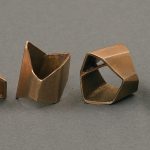Wilmington’s industrial might is slowly washing out, but its legacy lives on at the Block Shirt Factory
By Isabel Zermani
Watching my city change isn’t easy. Mainly, I no longer can give accurate directions. As people flood in, I can’t say “past the old . . .” or “next to the new . . .” without eliciting that dazed look. Newcomers will never know the shade of the “Sonic Oak” or when Mayfaire looked more like Mayberry.
Not a total Luddite, I, too, celebrate progress — God knows, we need it after a recession that endured long beyond when we were told it was over — but it requires a leap of faith. It means taking a risk and enduring the awful hallway between the door that shuts and the door that opens. What that looks like in Wilmington is construction.
We are a boomtown again.
But some of the detonators of this growth spurt are doing something really smart: a combination of historic preservation and arts patronage that keeps the embers of legacy warm.
One of those is Mark Maynard Jr. of Tribute Companies Inc. South Front, the former housing project barracks turned hipster paradise, is the brainchild of these developers who are underway with Phase II, the Block Shirt Factory.
Maynard approached local metal artist Michael Van Hout to create a 30-foot triptych mural for the development’s entryway to honor the building’s history. Maynard dug up some photographs from the archives and then “totally left it up to me,” says Van Hout.
The mural centerpiece is a 1960s factory scene of women working, a time-stamp of when women joined the workforce in droves. You can almost hear The Shirelles playing except that the humming of the machines would’ve drowned out any music. Van Hout traces the round faces and bouffants of these women with wire, then draws the receding perspective of the long busy factory room, cross-cut by looping air hoses hanging from the ceiling.
Van Hout’s keen ability to convey meaning with simple contour lines, to capture pure expression with a bent wire is uncanny. He would say “elemental.”
He comes by it honestly. Not looking for art, he found it in bailing wire while working as a groundskeeper, spreading pine straw, at NC State after having dropped out of his forestry major. It was the ’70s and he conjured Bob Dylan faces from disposable wire until some friends talked him into studying sculpture at UNCG. Van Hout still uses industrial materials in his work. The wire comes wound up in oil and he has to stretch and strip it in the yard outside his studio at Acme.
Something about the material, the medium of wire, is so fitting for an homage to Block Shirts, or their other moniker “Southland Manufacturing Corp.”
When Nathan Block, son of William Block, came down to Wilmington to expand their underwear manufacturing business in 1923, he brought 25 sewing machines and maintained them himself. I wonder if his hands were oiled and pinched like Van Hout’s who tapes his fingertips like a pre-game ritual before working with the sharp wire.
No stranger to hard work, William Block was only 13 years old in 1890 when he immigrated to Baltimore from Riga, Latvia, where his mother operated a shirt-making business. William excelled in manufacturing, married, had four children and eventually shifted his operations to Wilmington, home to two cotton mills. He bought a house near the temple. His business switched from underwear to shirts, which turned out to be a fortuitous move. By 1937, they were the largest manufacturer of shirts in the South producing 24,000 per week and employing 350 people.
The first panel of Van Hout’s triptych shows the exterior of the Block Shirt factory as it was then, large brick buildings between 3rd and Front Streets on Greenfield Street where the corporation operated until 1992. Block Shirts would reach far beyond downtown Wilmington, opening factories in the “Far East” in the global 1980s, grossing over $100 million a year, and stocking shirts in 10,000 retailers.
“The block-long home of the famous Block shirts” reads an old advertisement for the Can’t Fade shirts that Van Hout used as source material. The final panel shows a store window, each proud shirt at a jaunty angle.
Once centers of industry, these brick shells will soon house hip apartments with high ceilings and a modern industrial aesthetic. American industry may be fading, but, as we build, the legacy of what came before shouldn’t.
Recommended reading: Tales of a Shirtmaker: A Jewish Upbringing in North Carolina by Susan Taylor Block.
Isabel Zermani, our senior editor, prefers the storied life.


